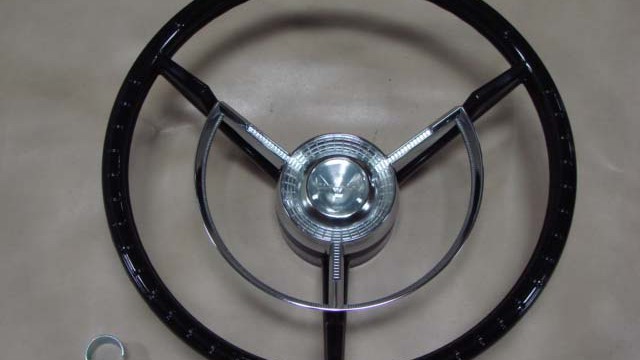
- #1956 ford thunderbird bird steering wheel driver
- #1956 ford thunderbird bird steering wheel manual
- #1956 ford thunderbird bird steering wheel free
- #1956 ford thunderbird bird steering wheel windows
American Cars, 1946-1959 Every Model Every Year. The 1957 Thunderbird was the last two-seater Ford sold until 1982 Ford EXP. 1957 sales were 21,380, including three extra months of production because the 1958 models were late. In addition to the standard 292 and optional 312 engines, higher performance versions of the 312 were offered, including two with a 4-barrel Holley carburetor McCulloch/Paxton centrifugal superchargers rated at 300 hp (304 PS 224 kW)at 4,800 rpm with a maximum torque of 439 lb⋅ft (595 N⋅m 61 kg⋅m) at 2,600 rpm and 340 hp (345 PS 254 kW), respectively. A new option was "Dial-o-Matic" 4-way power seats that would move rearward when the ignition was turned off to allow easier exit and entry. The side "Thunderbird" script was moved from the fins to the front fenders. The spare wheel moved back inside the trunk, which had been redesigned to allow it to be mounted vertically. Production total for 1956 was 15,631 units, the lowest of all three 2-seater Thunderbird model years.įor the 1957 model year, the front bumper was reshaped, the grille and tailfins were made larger, and larger taillights were fitted. A 312 cu in (5.1 L) Y-block V8 was added as an option.
#1956 ford thunderbird bird steering wheel windows
To improve rear-quarter visibility with the removable hardtop in place, "porthole" windows were available as a no-cost option.
#1956 ford thunderbird bird steering wheel free
1956 1956 Ford Thunderbirdįor the 1956 model year, more trunk space was added, the spare wheel was mounted outside (which helped free up trunk space), the exhaust tips were moved to the ends of the bumper, and air vents were added behind the front wheels to improve cabin ventilation. Ī rare domestic two-seater for the era, it was designed to be a brisk luxury tourer and not a sports car, capable of attaining speeds of 100 to 115 mph (161 to 185 km/h) depending on the transmission ordered.

Other unique features were a telescoping steering wheel and a tachometer.
#1956 ford thunderbird bird steering wheel manual
The engine was paired either with a Fordomatic automatic or manual overdrive transmissions, and the car featured four-way powered seats and pushbutton interior door handles. It was constructed using a body-on-frame technique utilizing a version of the standard Ford design cut-down to a 102-inch wheelbase identical to the Corvette's. The car used existing chassis and suspension design and off-the-shelf Ford mechanical components. The exhaust pipes exited through twin bumper guards bolted to the rear bumper.

The engine was Ford's 292-cubic-inch OHV 292 Y-block V8, which got 18 mpg ‑US (13 L/100 km 22 mpg ‑imp). The Thunderbird came with a removable fiberglass top as standard equipment, with a fabric convertible top as a commonly specified option. While only 10,000 were planned, 16,155 cars were sold with a listed retail price of US$2,944 ($32,161 in 2022 dollars ) in 1955. The first production car came off the line on September 9, 1954, and went on sale on October 22, 1954, as a 1955 model, and sold briskly 3,500 orders were placed in the first ten days of sale.

1955 1955 Ford Thunderbirdįord unveiled the Thunderbird at the Detroit Auto Show on February 20, 1954. The design of this generation of the Ford Thunderbird was the direct inspiration for the German Auto Union 1000 Sp. This remained the only two-seat convertible Thunderbird until the eleventh-generation was unveiled in 2002. The Thunderbird proved more suited to the American market than the Corvette, with sales of 16,155, versus 674 Corvettes in 1955.
#1956 ford thunderbird bird steering wheel driver
While light weight for its era and fitted with a standard V8 engine, the Thunderbird focused more on driver comfort than speed, and was not a direct rival to either the Corvette or European sports cars. The car built upon the heritage of the bespoke roadsters of the 1930s, yet was constructed largely of existing components, marking the first step toward the evolution of the personal luxury car as a mass market segment in the United States. ĭubbed a "a personal car of distinction" by Ford, this appellation was also used by the motoring press at the time. The Corvette in turn was developed in response to the popularity of European sports cars among Americans. It was developed in response to the 1953 Motorama display at the New York Auto Show, which showed the Chevrolet Corvette. The first generation of the Ford Thunderbird is a two-seat convertible produced by Ford for the 1955 to 1957 model year, the first 2-seat Ford since 1938.


 0 kommentar(er)
0 kommentar(er)
